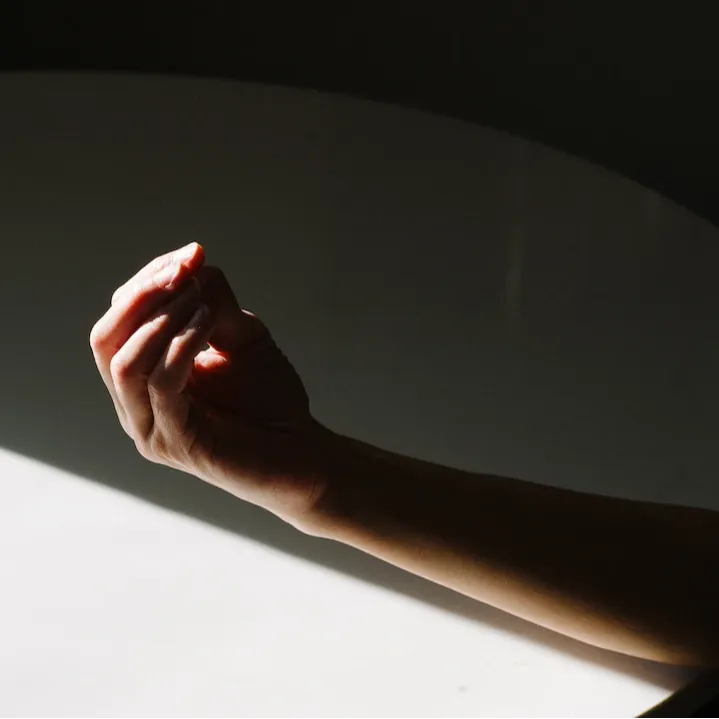Your Somatic Profile:
The Protector
Your nervous system has learned to respond to life's stressors through withdrawal and protection - what Thomas Hanna* called the "Red Light Reflex." This is your body's intelligent way of dealing with overwhelm, worry, or situations that feel too demanding.
*[Somatics by Thomas Hanna]

"I'm waiting for this to be over."
The Hidden Pattern:
Your nervous system automatically contracts your front body muscles as protection.
This helpful reflex, once vital for coping, has now become an unconscious habit—one that may be limiting your breathing, posture, and sense of openness.
Why This Pattern Developed
Your pattern likely developed from:
- Ongoing worry, anxiety, or caregiving stress
- Feeling overwhelmed by life's demands
- Needing to "get through" challenging periods
- Natural tendency toward being careful and protective
- Spending long hours sitting or curled inward—at a desk, on the couch, or looking down at a screen—reinforces this protective shape over time

How this shows up in your body
- Tendency to round forward or hunch, especially when tired
- Shallow breathing, particularly when stressed
- Feeling like you need to "unfold" or open up
- Preference for gentle, less demanding activities
- Sometimes experiencing digestive issues or tension headaches
- Spending long hours sitting or curled inward—at a desk, on the couch, or looking down at a screen—reinforces this protective shape over time

Common pain points and physical symptoms you may experience
- Chronically sore shoulders and neck
- Stooped posture with slumping shoulders and chest
- Aching knees from altered walking patterns
- Chronically fatigued and sore thigh muscles
- Soreness under the knee joint and behind the knee
- Shallow breathing that limits oxygen and energy
- Constipation and digestive issues
- Hypertension (high blood pressure)
- Development of "dowager's hump" over time
- Hemorrhoids from chronic tension patterns
- Underlying feelings of fear and anxiety held in the body

Why This Pattern Makes Sense
According to Hans Selye’s General Adaptation Syndrome, the body responds to chronic stress in 3 stages — the alarm stage, the resistance stage, and the exhaustion stage.
The Protector pattern represents that alarm phase—where the system reacts to perceived danger by pulling inward, bracing, and preparing to survive.
This response was natural. It helped you stay safe when things felt overwhelming or too much to handle.
But now, your nervous system may be signaling that it’s time to update the strategy — and begin exploring what it feels like to move with more safety, openness, and trust.
THE TAKEAWAYS

The Hidden Pattern
Your nervous system automatically contracts your front body muscles as protection, but this helpful response has become an unconscious habit that may be limiting your breathing, posture, and sense of openness.

What This Means:
You're not broken or just getting old. Your nervous system developed this pattern to help you cope. Now you can learn to consciously release it when it's no longer needed.

Somatic Learning Goals
Learn to recognize the feeling of your dominant pattern. Reduce anxiety. Restore, Elongate, Lengthen, and Decompress, Breathe Freely.

If this sounds familiar, you're not imagining it—and you're not alone.
Many people feel confused by chronic pain or posture issues that don’t improve, even with exercise, stretching, or bodywork. That’s because the root of the pattern isn’t just physical.
It’s neurological.
Your Protector pattern didn’t come from doing something wrong. It’s an involuntary, adaptive response your brain and nervous system developed in response to the experiences you’ve lived through—especially chronic stress, overwhelm, or caregiving demands.
Over time, this response became habituated—stored in your nervous system’s memory as the “safe” way to move and organize yourself.
But just like it was learned, it can be re-educated—gently, and through the right kind of process.
Note:
This quiz draws on Hans Selye’s General Adaptation Syndrome, a widely recognized model of how the body responds to stress in three stages: alarm, resistance, and exhaustion. Chronic or unresolved stress may lead to long-term adaptations in posture, movement, and energy — patterns that can be updated through gentle, brain-based learning.
Now let’s help your brain learn something new.
You’ve just uncovered an important pattern in your nervous system—and now it’s time to take the next step.
Hi, I'm Adrienne and I've been a movement educator and clinical somatic practitioner for over 20 years.
In this short video, I’ll show you:
- Why these patterns develop (and why they stick around)
- How they affect your body, your energy, and even your emotions
- What it really takes to change them—gently, from the inside out
And I’ll introduce you to UNA-The 20 Minute Movement Makeover System, so you can start re-wiring your responses and moving with more ease—right away.
Click play to learn what your body has been trying to tell you—and how to finally respond with something that works.
Your Next Step: Try The Moovy Studio Membership
You don’t need to figure this all out—you just need to start where you are.
Inside The Moovy Studio Membership, you'll access the UNA 20 Minute Movement Makeover System, where you’ll experience gentle, brain-based lessons that help you decompress, re-coordinate, and rediscover your somatic intelligence—without strain or pressure.
Just 20 minutes can shift your entire experience of being in your body.
⇨Start your 10 day Guest Pass.
Gentle. Brain-based. Designed for you.
Start Your 10-Day Guest Pass

"I'm working the lessons almost daily. Noticing changes on every level, especially in getting things I've put off taken care of. I'm looking forward to exploring, learning and shifting in more ways."
Margaret P.
"Since beginning UNA I've made it a habit to do 2 lessons a week. It began as a response to pain in my legs but soon broadened into a process of learning about myself. I look forward to each week and find the results remarkable."